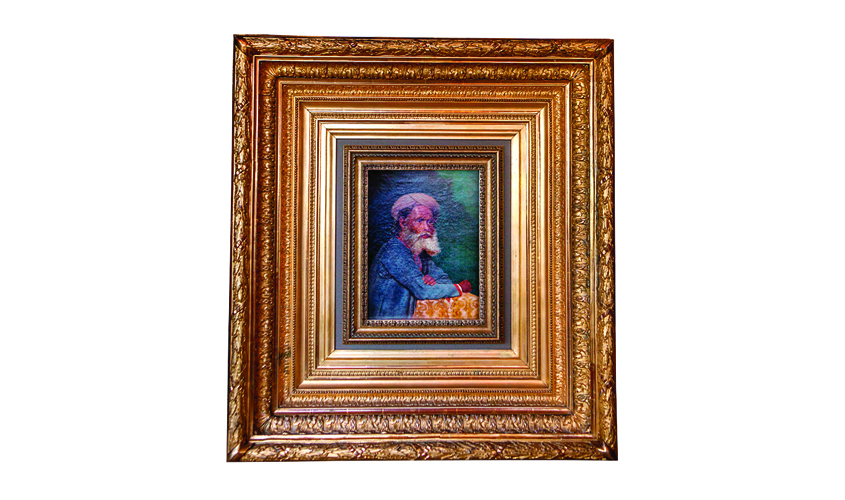Framing, if done wisely, heightens the effect of the central artwork on the viewer. Perhaps, it would have been simpler for many if the concept of physically framing the artwork didn’t exist, as the artist would then be left only with the sole aim of creating the work, minus these seemingly peripheral concerns. But as it happens, framing pictures is a practice that has been around for hundreds of years, and it is undeniably regarded as an important tool for accentuating the effects of an artwork.
Rajiv Savara, a prominent India art collector realised the importance of framing after a few years into collecting. He calls frames as an “extension of an artwork”. “When we first started collecting, our interaction was understandably with gallerists and dealers in India who would always express
Anchal Shinde, founder of Art and Aesthetic gallery, believes that a frame should never take the viewer’s eyes away from the centrepiece. “I think it is very important that a frame does not overpower the artist’s work. Sometimes, people think that a good frame means elaborate and intricate design which is not always true. A simpler frame can also add great significance to your artwork,” she says.
Most of the time, it is a task for the curator to choose a good frame to complement an image. Amrita Varma, founder-curator of Egg Art Gallery, believes that a good framework can transform the work of art. She says, “The frame always has to work around the artwork, it should harmonise with the subject. A picture, for instance, might appear dull or bright depending upon the casing used. As a curator, I try to transfer my visualisation to the audience and framing does play an important role in that sense.”
Varma shares the process of choosing a frame. She says, “For a previous photography exhibition at the gallery I chose wooden bronze frame as the images displayed had a classic touch in them. I always choose the frames myself and I prefer to look at the frames in my gallery itself as it is always better to keep the artwork in a temperature controlled atmosphere to safeguard them.”
Art advisor Farah Siddiqui has thought a lot about which kinds of frames should be used in order to protect and preserve works of art. She says, “It’s better to frame paper works in museum quality glass especially for high value artworks, and photographs to protect them. Also, the effect is clear and stunning.”

But this comes with a cost. “The museum quality glass, which no doubt offers great quality, is four times higher in price than the regular glass used,” says art restorer Priya Khanna, who would always prefer collectors to use this kind of framing material.
Seconding Priya’s view, Abhinit Khanna, an art advisor and collector, says, “Framing costs are always fixed and you cannot negotiate that with the gallery. They always give you an option where you can take the work unframed and not pay for framing. But if the work already comes framed, then one has to pay the framing charges. I recently wanted to acquire a work which was mounted on aluminium but had no framing. The price to frame the work was costing me around Rs 10,000 so I had to rethink about acquiring that work. I ultimately didn’t acquire the work because of its expensive framing.”
Priya also cautions against inexperienced framers. She says, “Many framers don’t know how to provide quality. I have seen a number of artworks where framing has done more damage than good to the piece. Very few framers use acid-free mounts and acid permeates into the painting when it is stuck directly to the hard cardboard. It is also imperative that framers employ termite-free wood for this purpose. Also, they should be careful while joining the artwork to a frame with nails as improper technique can lead to chipping of the paint. Along with it, the use of synthetic frames should be avoided. All this requires professional hands.”
A popular choice within the art community for framing is Delhi’s Ahuja Framers. Having been in the business for more than three decades now, Deepak Ahuja runs the family business in Delhi’s Paharganj. He says, “We have made frames for prominent artists like M.F. Husain, Paramjit Singh, Manu Parekh and others. We even make frames for Amitabh Bachchan. We have also designed ornate frames in the past.”
“Ornate, elaborate frames well represented an era gone by,” says Sushmit Sharma, curator at Delhi’s National Gallery of Modern Art. “I would always see Tanjore paintings and Raja Ravi Varma’s paintings in those kinds of frames. The nature of painting and frames together brought out an overall aesthetic effect of the painting and the sense of the era. But we see extensive use of simpler frames in contemporary times.”
Be it simple or ornate, it is essential for an artist to give careful consideration to framing. Antara Pain, a Mumbai-based artist, in her first exhibition used a frame that didn’t please her. She says, “Looking at my painting after framing it, I didn’t quite like it. I realised, I shouldn’t have used a black frame. I should also have left a little breathing space for the artwork. What I needed was a thick white mount followed by framing. An artist doesn’t know who will buy her artwork and which house it will be going to. Usually people match the art with their furniture, which is a sad thing, and black is universal.”

